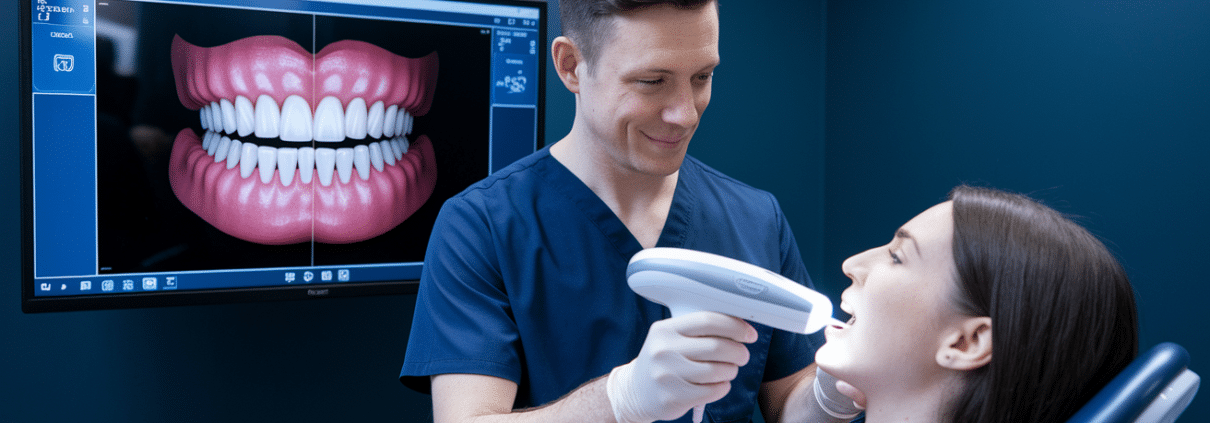Oral cancer doesn’t always announce itself with obvious symptoms. In fact, many people miss the early warning signs completely—until it’s too late. That’s why oral cancer screening is critical. It’s fast, non-invasive, and could quite literally save your life.
Whether it’s part of your regular check-up or a targeted exam based on risk factors, early detection gives you the best shot at beating it. When caught early, oral cancer has a survival rate of over 80%. When ignored? That number drops dramatically.
TLDR – Quick Guide
- Oral cancer screening is a simple, in-office exam.
- It checks for abnormalities in the mouth, lips, tongue, and throat.
- Early detection significantly increases treatment success.
- Ideal for both high-risk and average-risk patients.
- Non-invasive and takes just a few minutes.
- Recommended during regular dental visits.
Detailed Breakdown
What Is Oral Cancer Screening?
Oral cancer screening is a visual and physical exam performed by your dentist to spot signs of cancer or precancerous conditions. It focuses on areas like the lips, tongue, cheeks, floor of the mouth, palate, and throat. Some practices also use advanced screening tools or dyes to detect abnormal cells that may not be visible to the naked eye.
Why It’s So Important
Oral cancer can be aggressive—and silent. In its early stages, it’s often painless and easy to miss. That’s what makes screening so vital. Catching it early dramatically improves the chances of successful treatment and recovery. It’s one of the few life-saving steps you can take during a routine dental visit.
Who Needs Oral Cancer Screening?
Everyone. While it’s especially important for patients over 40 and those who use tobacco or alcohol, oral cancer doesn’t discriminate. Even younger, healthy individuals can be affected, particularly with the rise of HPV-related oral cancers. Screenings are quick, risk-free, and beneficial for all patients.
What to Expect During the Exam
Your dentist will examine your entire mouth, throat, and neck for any signs of discoloration, lumps, or tissue irregularities. They may gently feel your neck and jaw for swollen lymph nodes or masses. If anything unusual is found, your dentist may recommend a biopsy or referral for further evaluation. The process is quick, painless, and often takes less than five minutes.
When Should You Get Screened?
Ideally, during every routine dental checkup—especially if you’re in a higher-risk category. If you notice persistent sores, white or red patches, difficulty swallowing, or changes in your voice, don’t wait for your next appointment. Get screened immediately.
Key Takeaways
- Oral cancer screening is simple and non-invasive.
- It’s essential for early detection and life-saving treatment.
- All patients—regardless of age or risk—can benefit.
- Dentists can catch warning signs long before symptoms appear.
- It should be part of your regular dental care routine.
FAQs
- Is oral cancer screening painful?
Not at all. The exam is visual and tactile, involving no needles, cuts, or discomfort. - How long does an oral cancer screening take?
Usually less than 5 minutes. It’s often done during your regular cleaning or checkup. - What are the signs of oral cancer?
Common signs include persistent sores, red or white patches, unexplained lumps, numbness, or difficulty swallowing. - Can I request a screening even if I’m low risk?
Absolutely. Early detection is beneficial for everyone, regardless of your risk profile. - How often should I get screened?
Ideally, during every routine dental checkup—typically twice a year. More frequently if you’re at higher risk.
Cavities are sneaky little troublemakers, especially in those deep grooves on your back teeth. Brushing helps—but let’s be real: even the most diligent brushers can’t always reach every crevice. That’s where dental sealants come in. These invisible shields offer powerful protection against decay with zero drama.
Whether you’re a parent looking out for your child’s smile or an adult wanting to avoid fillings down the road, dental sealants are a smart move. They’re quick, affordable, and highly effective.
TLDR – Quick Guide
- Dental sealants are thin protective coatings applied to molars.
- They block food, plaque, and bacteria from settling into grooves.
- Most often used for children but equally effective for adults.
- Fast, painless, non-invasive procedure.
- Can last up to 10 years with proper care.
- Reduces risk of cavities by up to 80%.
Detailed Breakdown
What Are Dental Sealants?
Dental sealants are clear or tooth-colored coatings applied to the chewing surfaces of your back teeth—those molars and premolars that are prime cavity targets. Made from biocompatible resin or glass ionomer materials, they act like a raincoat for your teeth, keeping harmful bacteria and food particles out.
Why They Work So Well
The grooves and pits on molars are ideal hiding spots for cavity-causing bacteria. Sealants smooth out those tricky areas, making it easier to clean and much harder for decay to take hold. Bonus: They don’t require drilling or numbing. Just a quick paint-and-cure, and you’re done.
Perfect for Kids… and Adults Too
Kids are the most common candidates since their newly erupted molars are extra vulnerable. But adults with deep grooves, no previous decay, or existing fillings can also benefit—especially if they’re prone to cavities. Preventive care isn’t just for the young. It’s for the smart.
The Procedure: Simple and Fast
No needles. No pain. Here’s what happens:
- Your dentist cleans the tooth.
- A special solution is applied to help the sealant bond.
- The sealant is painted on.
- It’s cured (hardened) with a light.
The whole process takes just a few minutes per tooth.
How Long Do They Last?
Dental sealants can protect your teeth for up to 10 years. Dentists will check them during regular visits and reapply if needed. Think of it as low-maintenance, high-impact defense for your teeth.
Cavity Protection Without the Cost
Sealants are one of the most cost-effective preventive treatments in dentistry. Many insurance plans cover them for children, and even for adults, the long-term savings in avoided fillings is well worth it.
Key Takeaways
- Dental sealants offer invisible, effective protection against cavities.
- The procedure is fast, painless, and non-invasive.
- Kids and adults can both benefit from this preventive treatment.
- Sealants reduce the risk of molar decay by up to 80%.
- They’re cost-effective and long-lasting with regular checkups.
FAQs
- Are dental sealants safe?
Yes. Dental sealants are made from FDA-approved, biocompatible materials and are safe for both children and adults. - How long do sealants last?
With good oral hygiene and regular dental visits, sealants can last up to 10 years before needing reapplication. - Do sealants hurt to apply?
Not at all. The application is completely painless, requiring no drilling or anesthesia. - Can adults get dental sealants?
Yes. While they’re commonly used for kids, adults with healthy molars and no prior fillings are also great candidates. - Are dental sealants covered by insurance?
Most insurance plans cover sealants for children. Coverage for adults varies, so it’s best to check with your provider.
Let’s be honest—traditional dental impressions are the worst. Gag-inducing trays, goopy materials, and long wait times make them a universal patient pain point. Enter intraoral scanners: sleek, handheld devices that digitally capture your entire mouth in stunning 3D. They’re not just high-tech gadgets; they’re game-changers for both patients and providers.
At Valery Sweeny, DDS in Los Angeles, CA, intraoral scanners are part of a broader commitment to comfort, precision, and leading-edge care. And if you’re not already sold on the tech, keep reading—we’re laying out exactly how this innovation is reshaping modern dentistry.
TLDR – Quick Guide
- Intraoral scanners replace messy molds with digital precision
- They reduce appointment times and improve treatment outcomes
- Digital files are easy to store, share, and analyze
- They enhance patient comfort and experience
- Practices like Valery Sweeny, DDS use them to elevate standard care
Detailed Breakdown
What Are Intraoral Scanners?
Intraoral scanners are compact handheld devices that use optical and laser technology to scan a patient’s mouth. Within minutes, they produce a highly detailed 3D digital model of teeth and gums—no impression material, no mess, no drama.
Traditional Impressions vs. Digital Scanning
Let’s do a side-by-side:
- Comfort: Digital scans are fast and non-invasive; traditional methods require biting into a gooey tray.
- Accuracy: Scanners can detect tiny details missed by molds.
- Speed: Digital models are generated in minutes and can be shared with labs instantly.
- Reusability: Digital files can be reused, modified, and reprinted—unlike one-and-done impressions.
The shift isn’t just about convenience. A study published in the Journal of Prosthodontic Research found that digital impressions improve the fit of restorations significantly compared to conventional methods.
How Dentists Benefit
For dental practices, intraoral scanners streamline workflows and elevate care:
- Improved Diagnosis: 3D models help dentists like Dr. Valery Sweeny catch early signs of misalignment, wear, or decay.
- Better Communication: Visual aids improve patient understanding and trust.
- Workflow Integration: Scans feed directly into CAD/CAM systems, enabling faster turnaround for crowns, bridges, and aligners.
Why Patients Love Them
Let’s be real—no one walks into a dental office hoping to choke on impression putty. Intraoral scanners eliminate that entire anxiety loop. Patients experience:
- Less chair time
- Greater comfort
- Fewer remakes or adjustment appointments
- Immediate visual feedback about their oral health
Use Cases in Everyday Dentistry
At Valery Sweeny, DDS, intraoral scanning is used for:
- Creating custom aligners like Invisalign®
- Preparing crowns and bridges
- Planning dental implants
- Monitoring oral health changes over time
And since these digital files can be stored long-term, returning patients don’t need to re-do impressions unless there’s been a major change.
Key Takeaways
- Intraoral scanners are redefining how dental impressions are made—faster, more accurate, and way more comfortable.
- They eliminate the need for traditional molds, cutting down on time and error.
- Dentists benefit from more precise diagnostics and streamlined workflows.
- Patients enjoy a far better experience with no goopy trays or gagging.
- Valery Sweeny, DDS uses intraoral scanners to provide cutting-edge, patient-first dental care.
FAQs
1. What is an intraoral scanner?
An intraoral scanner is a digital device that captures 3D images of your teeth and gums. It replaces traditional dental molds with a faster, cleaner, and more comfortable digital scan.
2. Is an intraoral scan safe?
Yes. Intraoral scanners are completely safe and use non-invasive imaging technology. They don’t emit radiation and are safe for children and adults alike.
3. How long does an intraoral scan take?
The scanning process usually takes about 3 to 5 minutes. Most patients are surprised at how quick and easy it is.
4. Can I see my scan right away?
Absolutely. One of the best perks of intraoral scanning is that your dentist can show you the digital model of your mouth instantly, helping you understand your oral health in real-time.
5. Are digital impressions as accurate as traditional ones?
Actually, they’re more accurate. Studies show digital impressions reduce the likelihood of errors and often result in better-fitting dental restorations.



